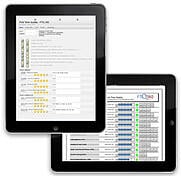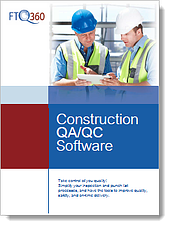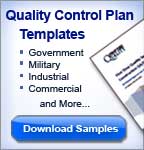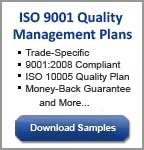 So you're the person who's been asked to write a quality plan — In this article, I’ll take you through a step-by-step process that will help you write your project-specific quality plan.
So you're the person who's been asked to write a quality plan — In this article, I’ll take you through a step-by-step process that will help you write your project-specific quality plan.
Let’s first take a look at the overall approach you'll use for writing your QC plan.
The key point to keep in mind is the reason clients ask for your quality plan is that they want to know how you are going to control the quality on their projects.
So, when you write your plan, make it clear how you will control all areas of the project that affect quality – not just what inspections and tests you’ll perform. For example, controlling materials, personnel, subcontractors, and work procedures also play an important role in ensuring quality results.
In the end, your quality plan should instill confidence in your clients that your quality controls will help them get the quality project that they expect.
Understanding what your client is looking for
Quality control can mean many things to a client. Therefore, the first step is to find out what your client is looking for. Sometimes this will appear as a specification or as a mention in one of the contract documents.
Other times your client will just say they need a quality control plan and leave you figure out what they want. Nonetheless, it’s definitely worthwhile having a conversation so you get a better understanding of what they have in mind or at least that they feel comfortable with your suggestion.
In the next sections, I will go over some of the baseline elements commonly found in a construction quality control plan.
As you put your quality control plan together, try to organize it so that your headings match up with your client’s specifications. This will make it easier for them to verify that your plan meets their requirements.
8 Essentials Elements of a Project-Specific Construction Quality Control Plan
1. Project personnel
Every project should have a designated quality manager – the one person in charge of the project quality. Your client needs to know who this person is and what his or her quality responsibilities are. Therefore, include this information in your quality plan along with the person’s qualifications for holding this position.
While the quality manager has overall responsibility for the quality of your project, your project superintendents are primarily responsible for the day-to-day field operations. Your project quality control plan should indicate what responsibilities your project superintendent(s) has and what his or her responsibilities are.
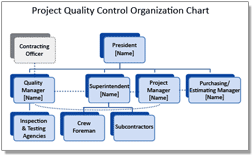 Include an organization chart to show independence between the quality manager and the project superintendent.
Include an organization chart to show independence between the quality manager and the project superintendent.
2. Quality Communications
Do you expect to have a project start-up meeting and routine production meetings where you will discuss quality issues? Will you be submitting reports, test results, and/or inspection forms to your client? Then, your quality plan should include a quality communications plan that defines the touch points that you expect to have with your client.
3. Quality assurance surveillance
A big concern of many clients is what management will be doing to monitor overall project quality and how they will make sure that the project quality controls are running the way that they should.
With this in mind, your client will expect some form of quality assurance surveillance. Will you be monitoring project quality on a weekly or monthly basis? What will you be reviewing? Lay it all out in your project quality plan so that your client has a good picture of how you will make sure that the project stays on track.
4. Subcontractors and suppliers.
Outside organizations play a huge role in supplying materials and carrying out work on construction projects. Tell your client what key suppliers and subcontractors you’ll be using on their project.
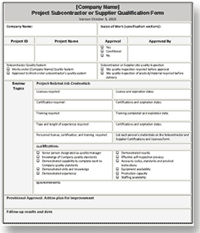 What criteria do you use to select your suppliers and subcontractors? In addition to price, most likely you checked that they were capable of performing the work or supplying quality materials.
What criteria do you use to select your suppliers and subcontractors? In addition to price, most likely you checked that they were capable of performing the work or supplying quality materials.
It is always a good idea to include the following in your quality plan:
- Procedures you followed for qualifying suppliers and subcontractors
- Listing of project suppliers and subcontractors
- Records of supplier and subcontractor qualifications
5. Project quality specifications
It goes without saying that you will comply with your customer’s specifications. However, in many cases, the customer specifications do not tell you which building codes or industry standards apply to your scope of work. List them so there’s no confusion as to which versions of what standards apply to your project.
6. Inspections and tests.
A normal part of any construction process is to inspect phases of work (like steel erection) and to perform tests that verify material quality (like concrete strength) or a system function (determined by plumbing pressure test).
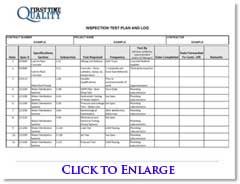 You should list all of the inspections and tests that you expect to be performing during the course of the entire project. You should also include the inspection forms and test reports that you will use when the time comes.
You should list all of the inspections and tests that you expect to be performing during the course of the entire project. You should also include the inspection forms and test reports that you will use when the time comes.
Most quality control plan specifications require you to submit procedures for conducting task inspections. I find it a good practice to include these procedures even if the client doesn’t specifically ask for them.
Your inspection procedures should include how you do the following:
- Make sure that work is ready to begin
- Handle material receiving and inspections
- Monitor work in process
- Verify that completed work meets project specifications
7. Control of nonconformances
Everyone understands that from time to time things go wrong in construction. Your quality plan should discuss how you will handle these situations. Make it clear how you will control nonconformances so that you protect the overall quality of the project.
Be sure you define controlling nonconformances in such a way that it does not include routine corrections and punch items, or you may end up creating a lot of extra paperwork for yourself.
Typical nonconformance procedures include:
- Preventing cover-ups
- Corrective actions
- Records you will keep of the incident
8. Project completion inspections.
All of the things that we have discussed so far have had to do with individual tasks and phases of work. You’ll also want to discuss how you will conduct inspections and punch out near the end of the project to assure that all of the contracted work is completed to specifications.
Conclusion
So there you have it. That’s my list of eight essential elements you should include in your project–specific construction quality control plan. Use my list as a guide.
Have I missed anything? What would you include? Leave me a comment. I’d love to hear from you.
About the Author - Ed Caldeira is founder of First Time Quality, LLC, specializing in submittal-ready construction quality plan templates and custom quality plans as well as construction quality inspection/punchlist software.


